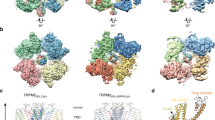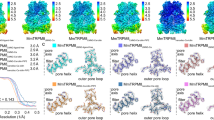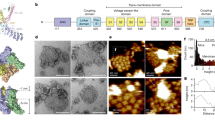Abstract
Ca2+-activated, non-selective (CAN) ion channels sense increases of the intracellular Ca2+ concentration, producing a flux of Na+ and/or K+ ions that depolarizes the cell, thus modulating cellular Ca2+ entry. CAN channels are involved in cellular responses such as neuronal bursting activity and cardiac rhythm. Here we report the electron cryo-microscopy structure of the most widespread CAN channel, human TRPM4, bound to the agonist Ca2+ and the modulator decavanadate. Four cytosolic C-terminal domains form an umbrella-like structure with a coiled-coil domain for the ‘pole’ and four helical ‘ribs’ spanning the N-terminal TRPM homology regions (MHRs), thus holding four subunits in a crown-like architecture. We observed two decavanadate-binding sites, one in the C-terminal domain and another in the intersubunit MHR interface. A glutamine in the selectivity filter may be an important determinant of monovalent selectivity. Our structure provides new insights into the function and pharmacology of both the CAN and the TRPM families.
This is a preview of subscription content, access via your institution
Access options
Access Nature and 54 other Nature Portfolio journals
Get Nature+, our best-value online-access subscription
$29.99 / 30 days
cancel any time
Subscribe to this journal
Receive 51 print issues and online access
$199.00 per year
only $3.90 per issue
Buy this article
- Purchase on Springer Link
- Instant access to full article PDF
Prices may be subject to local taxes which are calculated during checkout






Similar content being viewed by others
References
Nilius, B. et al. Voltage dependence of the Ca2+-activated cation channel TRPM4. J. Biol. Chem. 278, 30813–30820 (2003)
Launay, P. et al. TRPM4 is a Ca2+-activated nonselective cation channel mediating cell membrane depolarization. Cell 109, 397–407 (2002)
Clémençon, B. et al. Expression, purification, and projection structure by single particle electron microscopy of functional human TRPM4 heterologously expressed in Xenopus laevis oocytes. Protein Expr. Purif. 95, 169–176 (2014)
Constantine, M. et al. Heterologously-expressed and liposome-reconstituted human transient receptor potential melastatin 4 channel (TRPM4) is a functional tetramer. Sci. Rep. 6, 19352 (2016)
Guinamard, R., Demion, M., Magaud, C., Potreau, D. & Bois, P. Functional expression of the TRPM4 cationic current in ventricular cardiomyocytes from spontaneously hypertensive rats. Hypertension 48, 587–594 (2006)
Harteneck, C. Function and pharmacology of TRPM cation channels. Naunyn Schmiedebergs Arch. Pharmacol. 371, 307–314 (2005)
Kraft, R. & Harteneck, C. The mammalian melastatin-related transient receptor potential cation channels: an overview. Pflugers Arch. 451, 204–211 (2005)
Clapham, D. E. TRP channels as cellular sensors. Nature 426, 517–524 (2003)
Fleig, A. & Penner, R. The TRPM ion channel subfamily: molecular, biophysical and functional features. Trends Pharmacol. Sci. 25, 633–639 (2004)
Perraud, A. L., Schmitz, C. & Scharenberg, A. M. TRPM2 Ca2+ permeable cation channels: from gene to biological function. Cell Calcium 33, 519–531 (2003)
Guinamard, R., Chatelier, A., Lenfant, J. & Bois, P. Activation of the Ca2+-activated nonselective cation channel by diacylglycerol analogues in rat cardiomyocytes. J. Cardiovasc. Electrophysiol. 15, 342–348 (2004)
Earley, S., Waldron, B. J. & Brayden, J. E. Critical role for transient receptor potential channel TRPM4 in myogenic constriction of cerebral arteries. Circ. Res. 95, 922–929 (2004)
Gonzales, A. L., Garcia, Z. I., Amberg, G. C. & Earley, S. Pharmacological inhibition of TRPM4 hyperpolarizes vascular smooth muscle. Am. J. Physiol. Cell Physiol. 299, C1195–C1202 (2010)
Barbet, G. et al. The calcium-activated nonselective cation channel TRPM4 is essential for the migration but not the maturation of dendritic cells. Nat. Immunol. 9, 1148–1156 (2008)
Stallmeyer, B. et al. Mutational spectrum in the Ca2+-activated cation channel gene TRPM4 in patients with cardiac conductance disturbances. Hum. Mutat. 33, 109–117 (2012)
Liu, H. et al. Molecular genetics and functional anomalies in a series of 248 Brugada cases with 11 mutations in the TRPM4 channel. PLoS ONE 8, e54131 (2013)
Demion, M. et al. Trpm4 gene invalidation leads to cardiac hypertrophy and electrophysiological alterations. PLoS ONE 9, e115256 (2014)
Hof, T. et al. TRPM4 non-selective cation channels influence action potentials in rabbit Purkinje fibres. J. Physiol. (Lond.) 594, 295–306 (2016)
Ullrich, N. D. et al. Comparison of functional properties of the Ca2+-activated cation channels TRPM4 and TRPM5 from mice. Cell Calcium 37, 267–278 (2005)
Hofmann, T., Chubanov, V., Gudermann, T. & Montell, C. TRPM5 is a voltage-modulated and Ca2+-activated monovalent selective cation channel. Curr. Biol. 13, 1153–1158 (2003)
Nilius, B., Prenen, J., Janssens, A., Voets, T. & Droogmans, G. Decavanadate modulates gating of TRPM4 cation channels. J. Physiol. (Lond.) 560, 753–765 (2004)
Nilius, B. et al. The Ca2+-activated cation channel TRPM4 is regulated by phosphatidylinositol 4,5-biphosphate. EMBO J. 25, 467–478 (2006)
Zhang, Z., Okawa, H., Wang, Y. & Liman, E. R. Phosphatidylinositol 4,5-bisphosphate rescues TRPM4 channels from desensitization. J. Biol. Chem. 280, 39185–39192 (2005)
Liao, M., Cao, E., Julius, D. & Cheng, Y. Structure of the TRPV1 ion channel determined by electron cryo-microscopy. Nature 504, 107–112 (2013)
Cao, E., Liao, M., Cheng, Y. & Julius, D. TRPV1 structures in distinct conformations reveal activation mechanisms. Nature 504, 113–118 (2013)
Shen, P. S. et al. The structure of the polycystic kidney disease channel PKD2 in lipid nanodiscs. Cell 167, 763–773 (2016)
Paulsen, C. E., Armache, J. P., Gao, Y., Cheng, Y. & Julius, D. Structure of the TRPA1 ion channel suggests regulatory mechanisms. Nature 520, 511–517 (2015)
Jin, P. et al. Electron cryo-microscopy structure of the mechanotransduction channel NOMPC. Nature 547, 118–122 (2017)
Chubanov, V. et al. Disruption of TRPM6/TRPM7 complex formation by a mutation in the TRPM6 gene causes hypomagnesemia with secondary hypocalcemia. Proc. Natl Acad. Sci. USA 101, 2894–2899 (2004)
Sun, J. & MacKinnon, R. Cryo-EM structure of a KCNQ1/CaM complex reveals insights into congenital long QT syndrome. Cell 169, 1042–1050 (2017)
Launay, P. et al. TRPM4 regulates calcium oscillations after T cell activation. Science 306, 1374–1377 (2004)
Fujiwara, Y. & Minor, D. L. Jr. X-ray crystal structure of a TRPM assembly domain reveals an antiparallel four-stranded coiled-coil. J. Mol. Biol. 383, 854–870 (2008)
Gregorio-Teruel, L. et al. The integrity of the TRP domain is pivotal for correct TRPV1 channel gating. Biophys. J. 109, 529–541 (2015)
García-Sanz, N. et al. A role of the transient receptor potential domain of vanilloid receptor I in channel gating. J. Neurosci. 27, 11641–11650 (2007)
Gregorio-Teruel, L., Valente, P., González-Ros, J. M., Fernández-Ballester, G. & Ferrer-Montiel, A. Mutation of I696 and W697 in the TRP box of vanilloid receptor subtype I modulates allosteric channel activation. J. Gen. Physiol. 143, 361–375 (2014)
Valente, P. et al. Identification of molecular determinants of channel gating in the transient receptor potential box of vanilloid receptor I. FASEB J. 22, 3298–3309 (2008)
Long, S. B., Tao, X., Campbell, E. B. & MacKinnon, R. Atomic structure of a voltage-dependent K+ channel in a lipid membrane-like environment. Nature 450, 376–382 (2007)
Voets, T., Owsianik, G., Janssens, A., Talavera, K. & Nilius, B. TRPM8 voltage sensor mutants reveal a mechanism for integrating thermal and chemical stimuli. Nat. Chem. Biol. 3, 174–182 (2007)
Lin, Z. et al. Exome sequencing reveals mutations in TRPV3 as a cause of Olmsted syndrome. Am. J. Hum. Genet. 90, 558–564 (2012)
Rohács, T., Lopes, C. M., Michailidis, I. & Logothetis, D. E. PI(4,5)P2 regulates the activation and desensitization of TRPM8 channels through the TRP domain. Nat. Neurosci. 8, 626–634 (2005)
Ahuja, S. et al. Structural basis of Nav1.7 inhibition by an isoform-selective small-molecule antagonist. Science 350, aac5464 (2015)
Wu, J. et al. Structure of the voltage-gated calcium channel Cav1.1 at 3.6 Å resolution. Nature 537, 191–196 (2016)
Nilius, B. et al. The selectivity filter of the cation channel TRPM4. J. Biol. Chem. 280, 22899–22906 (2005)
García-Martínez, C., Morenilla-Palao, C., Planells-Cases, R., Merino, J. M. & Ferrer-Montiel, A. Identification of an aspartic residue in the P-loop of the vanilloid receptor that modulates pore properties. J. Biol. Chem. 275, 32552–32558 (2000)
Tang, L. et al. Structural basis for Ca2+ selectivity of a voltage-gated calcium channel. Nature 505, 56–61 (2014)
Goehring, A. et al. Screening and large-scale expression of membrane proteins in mammalian cells for structural studies. Nat. Protoc. 9, 2574–2585 (2014)
Varga, S., Csermely, P. & Martonosi, A. The binding of vanadium (V) oligoanions to sarcoplasmic reticulum. Eur. J. Biochem. 148, 119–126 (1985)
Csanády, L. & Adam-Vizi, V. Antagonistic regulation of native Ca2+- and ATP-sensitive cation channels in brain capillaries by nucleotides and decavanadate. J. Gen. Physiol. 123, 743–757 (2004)
Mastronarde, D. N. Automated electron microscope tomography using robust prediction of specimen movements. J. Struct. Biol. 152, 36–51 (2005)
Zheng, S ., Palovcak, E ., Armache, J.-P ., Cheng, Y. & Agard, D. Anisotropic correction of beam-induced motion for improved single-particle electron cryo-microscopy. bioRxiv (2016)
Zhang, K. Gctf: Real-time CTF determination and correction. J. Struct. Biol. 193, 1–12 (2016)
Scheres, S. H. W. RELION: implementation of a Bayesian approach to cryo-EM structure determination. J. Struct. Biol. 180, 519–530 (2012)
Punjani, A., Rubinstein, J. L., Fleet, D. J. & Brubaker, M. A. cryoSPARC: algorithms for rapid unsupervised cryo-EM structure determination. Nat. Methods 14, 290–296 (2017)
Grigorieff, N. Frealign. Methods Enzymol. 579, 191–226 (2016)
Emsley, P., Lohkamp, B., Scott, W. G. & Cowtan, K. Features and development of Coot. Acta Crystallogr. D 66, 486–501 (2010)
Singharoy, A. et al. Molecular dynamics-based refinement and validation for sub-5 Å cryo-electron microscopy maps. eLife 5, e16105 (2016)
Chen, V. B. et al. MolProbity: all-atom structure validation for macromolecular crystallography. Acta Crystallogr. D 66, 12–21 (2010)
Pettersen, E. F. et al. UCSF Chimera—a visualization system for exploratory research and analysis. J. Comput. Chem. 25, 1605–1612 (2004)
DeLano, W. L. The PyMOL Molecular Graphics System; http://www.pymol.org (2002)
Acknowledgements
Cryo-EM data was collected at the David Van Andel Advanced Cryo-Electron Microscopy Suite in the Van Andel Research Institute (VARI) and we are grateful to G. Zhao and X. Meng for technical support. We thank C. Xu for help with SerialEM, the HPC team at VARI for computational support and D. Nadziejka for proofreading. This work is supported by internal funding from VARI.
Author information
Authors and Affiliations
Contributions
W.L. designed the project. P.A.W., Y.H. and W.L. purified TRPM4 and performed cryo-EM data collection and processing. W.S. performed electrophysiological experiments. W.L. and J.D. analysed the data and wrote the manuscript. All the authors contributed in preparing the manuscript.
Corresponding author
Ethics declarations
Competing interests
The authors declare no competing financial interests.
Additional information
Publisher's note: Springer Nature remains neutral with regard to jurisdictional claims in published maps and institutional affiliations.
Extended data figures and tables
Extended Data Figure 1 Cryo-EM analysis of TRPM4 in complex with agonist calcium and the modulator DVT.
a, Representative electron micrograph. b, Selected two-dimensional class averages of the electron micrographs. c, The gold-standard Fourier shell correlation curves for the electron microscopy maps are shown in black and the FSC curves between the atomic model and the final EM map are shown in blue. d, Angular distribution of particles used for refinement. e–g, Local resolution estimation. The map is coloured according to local resolution estimation.
Extended Data Figure 4 Densities of DVT1, DVT2 and neighbouring protein.
a–d, DVT1. e–h, DVT2. Protein is shown in cartoon representation, whereas DVT molecules are shown in spheres and lines. The densities are contoured at different σ levels (from left to right, 0.03 (a, e), 0.04 (b, f), 0.05 (c, g) and 0.06 (d, h)), showing strong densities of DVT molecules and clear boundaries between DVT molecules and neighbouring protein.
Extended Data Figure 5 Calcium activation and DVT modulation of TRPM4.
a, Application of 0.5 mM Ca2+ onto inside-out patches pulled from HEK-293 cells transfected with TRPM4 plasmid elicited currents at +60 mV. Flufenamic acid (FA, 100 μM) blocked the Ca2+ induced current by 98 ± 6% (mean ± s.e.m., n = 3 cells). b, 100 μM ATP4− blocked Ca2+ induced current by 81 ± 11% (n = 3 cells). c, Top, an inside-out patch showing single channel activity when exposed to 0.5 mM Ca2+. Single channel current had a mean amplitude of 1.8 pA, corresponding to a single channel conductance of 30 pS. Bottom, channel activities were not observed from non-transfected cells (n = 4 cells). d–f, After application of 0.5 mM (d), 1 mM (e) or 5 mM (f) CaCl2, alternating voltage commands were delivered (±100 mV, 1 s pulses). Once the current amplitude at both voltages stabilized, 10 μM DVT was co-applied with CaCl2. At 0.5 mM Ca2+, 10 μM DVT blocked Ca2+ induced currents by 67 ± 5% (n = 4 cells, P = 0.001) at +100 mV and did not change current amplitude at −100 mV (n = 4 cells, P = 0.148). At 1 mM Ca2+, 10 μM DVT blocked Ca2+ induced currents by 56 ± 14% (n = 4 cells, P = 0.013) at +100 mV while 10 μM DVT potentiated the currents by 322 ± 83% at −100 mV (n = 4 cells, P = 0.030). At 5 mM Ca2+, 10 μM DVT did not change current amplitude (n = 4 cells, P = 0.517) but potentiated Ca2+ induced currents at −100 mV by 520 ± 147% (n = 4 cells, P = 0.035). Two-sided t-tests were used for statistical comparisons. Observations of the inhibitory effect of DVT at 0.5 mM Ca2+ is more pronounced compared to previously reported data21, where the authors only occasionally saw inhibitory effect of DVT at positive potentials, and the extent of inhibition was less pronounced. The reason for this discrepancy is not clear; we suspect differences in construct, solution composition, solution pH, cell line, transfection methods, other variations in experimental protocols or combinations of these factors. Although the effects of DVT on current amplitude varied with calcium concentration, 10 μM DVT linearized the current–voltage relationship in all three calcium concentrations (see g–l). g–i, 500 ms voltage pulses ranging from −140 mV to 140 mV from a holding potential of 0 mV (20 mV step size) were used to obtain the current–voltage relationship. Currents recorded in the presence of 0.5 mM (g, left), 1 mM (h, left) or 5 mM (i, left) Ca2+. Currents recorded in the presence of 0.5 mM (g, right), 1 mM (h, right) or 5 mM (i, right) Ca2+ with 10 μM DVT from the same patch. j–l, Currents recorded with Ca2+ and Ca2+ and DVT (Ca2+ concentrations as in g–i) at different voltages, data are normalized to the amplitude of current recorded with Ca2+ at 140 mV. g–l, Data are mean ± s.e.m. from four (h, i, k, l) or five (g, j) cells, experiments repeated three times for each cell. Leak currents were obtained by running the same voltage command when no calcium was applied and were subtracted from the currents recorded in Ca2+ for all experiments in d–l.
Extended Data Figure 6 Structure of TRPM4.
a, TRPM4 tetramer viewed parallel to the membrane. b–d, Slice views of a, viewed from parallel to the membrane (b), from the extracellular side of the membrane (c), or from the cytosolic side (d). The four subunits are in blue, pink, green and yellow.
Extended Data Figure 7 Secondary structure prediction of human TRPM4 and sequence alignment of TRPM4, TRPM5, TRPM2, TRPM8, TRPA1 and NOMPC.
The NOMPC is from Drosophila, whereas all the other proteins are human. The secondary structure prediction of TRPM4 was done using the JPred online server. The sequences were aligned using the Clustal Omega program on the Uniprot website and coloured using BLOSUM62 score by conservation. Residues that coordinate DVT1 or DVT2 in TRPM4 are marked with filled circles or triangles, respectively. Residues that correspond to R0, Q1, R2, R3, R4, K5 and R6 in the S4 of Kvchim (PDB accession number 2R9R, Extended Data Fig. 8) are marked with 0, 1, 2, 3, 4, 5 and 6, respectively.
Extended Data Figure 8 Comparison of the voltage sensor domain (S1–S4) in TRPM4 and in Kvchim.
a, b, The S4 and S4–S5 linker in TRPM4 (a) or Kvchim (b) are in green or orange, respectively. The residues at positions R0, Q1, R2, R3, R4, K5 and R6 in Kvchim, and the corresponding residues in TRPM4 are shown as sticks. The two positively charged residues (K914 and K919) in S4–S5 linker of TPRM4 are also shown as sticks.
Extended Data Figure 9 Comparison of the pore in TRPM4 (yellow) and in TRPV1 (grey).
The P loop and S6 of two subunits are shown in cartoon representation and the side chains of restriction residues are shown as sticks. Restriction residues in TRPM4 or TRPV1 are in black or green, respectively. Purple, green, and red spheres define radii of >2.3, 1.2–2.3, and <1.2 Å, respectively.
Supplementary information
Source data
Rights and permissions
About this article
Cite this article
Winkler, P., Huang, Y., Sun, W. et al. Electron cryo-microscopy structure of a human TRPM4 channel. Nature 552, 200–204 (2017). https://doi.org/10.1038/nature24674
Received:
Accepted:
Published:
Issue Date:
DOI: https://doi.org/10.1038/nature24674
This article is cited by
-
TRPM channels in health and disease
Nature Reviews Nephrology (2024)
-
TRPM5 activation depends on a synergistic effect of calcium and PKC phosphorylation
Communications Biology (2024)
-
Structural mechanisms of TRPM7 activation and inhibition
Nature Communications (2023)
-
TRP (transient receptor potential) ion channel family: structures, biological functions and therapeutic interventions for diseases
Signal Transduction and Targeted Therapy (2023)
-
Structure of human TRPM8 channel
Communications Biology (2023)
Comments
By submitting a comment you agree to abide by our Terms and Community Guidelines. If you find something abusive or that does not comply with our terms or guidelines please flag it as inappropriate.



